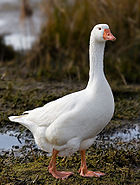Domestic goose
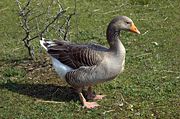
Domestic geese (Anser anser domesticus or Anser cygnoides domesticus subspecies) are domesticated Grey geese (either Greylag geese or Swan geese) kept as poultry for their meat, eggs, and down feathers since ancient times.
Contents |
Origins and characteristics
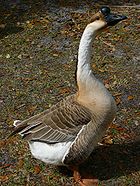
upright posture
and fat rear end
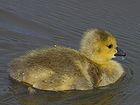
In Europe, northern Africa, and western Asia, the original domesticated geese are derived from the Greylag Goose Anser anser. In eastern Asia, the original domesticated geese are derived from the Swan Goose Anser cygnoides; these are now known as Chinese geese. Both have been widely introduced in more recent times, and modern flocks in both areas (and elsewhere, such as Australia and North America) may consist of either species, and/or hybrids between them. Chinese geese may be readily distinguished from European geese by the large knob at the base of the bill, though hybrids may exhibit every degree of variation between them.[1]
The domestication, as Charles Darwin remarks (Animals and Plants under Domestication, i. 287), is of very ancient date, with archaeological evidence for domesticated geese in Egypt 5,000 years ago.[2]They are much larger,and they have been selected for that larger size, with domesticated breeds weighing up to 10 kg,[2] compared to the maximum of 3.5 kg for wild Swan Goose and 4.1 kg for wild Greylag Goose.[3] This affects their body structure; whereas wild geese have a horizontal posture and slim rear end, domesticated geese lay down large fat deposits toward the tail end, giving a fat rear and forcing the bird into a more upright posture. This also completely prevents flight, though geese will run and flap their wings when startled, and may get a foot or so in the air momentarily.
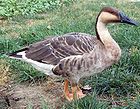
horizontal posture
and slim rear end
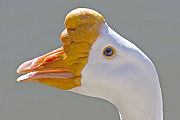
They have also been strongly selected for fecundity, with females laying up to 160 eggs per year, compared to 5–12 eggs for a wild goose.[2][3]
Changes to the plumage are variable; many have been selected to lose dark brown tones of the wild bird. The result is an animal marked, or completely covered in white feathers. Others retain plumage close to the natural; some, such as the modern Toulouse goose looks almost identical to the Greylag in plumage, differing only in structure. White geese are often preferred as they look better plucked and dressed, with any small down feathers remaining being less conspicuous. From the time of the Romans, white geese have been held in great esteem.
The most recognized breeds of domestic geese are those with the distinctive names of Embden and Toulouse, but a singular breed, said to have come from Sevastopol, called the Sebastopol Goose, was introduced into western Europe in 1856. In this breed, the upper plumage is elongated, curled and spirally twisted. Their shaft is transparent and so thin that it often splits into fine filaments, which, remaining free for 2-3 cm, often coalesce again; while the quills are aborted, so that the birds cannot fly.
Geese have proved resistant to intensive rearing methods, and they remain to be an expensive luxury compared to other poultry like the chicken and domesticated turkey.
Geese produce large edible eggs, weighing 120-170 g.[2] They can be used in cooking just like chicken's eggs, though they have proportionally more yolk, and this cooks to a slightly denser consistency. The taste is much the same as that of a chicken egg.
Geese in cooking

A goose can be roasted as a whole bird, but its size tends to preclude this except for banquets and other festive meals (such as at Christmas). Goosemeat contains much more fat than turkeys or chickens - at least 500 ml (around one pint) of fat may be rendered from an average-sized goose during cooking. One litre is not unusual for larger birds. The Cantonese barbecue features roast goose over a charcoal spit with a "tuned" crispy skin. Roast goose is a traditional Christmas food in Scandinavia, Germany, Ireland and the UK.
Most of the fat is concentrated in the skin, and the meat itself is very lean, rather like duck.
Goose fat is often separated and stored for use on its own. It can be used as a substitute for butter, although the flavour can be slightly "gamey". Potatoes cooked in this fat are highly regarded by some. The fat keeps well in the refrigerator. Goose schmaltz is very popular in Ashkenazi Jewish cuisine, and the overfeeding of geese to produce this schmaltz is widely considered to be the origin of foie gras in modern Europe. Goose can also be prepared as confit, and the fat used to preserve the meat.
Goose livers are also used in the production of foie gras.
Hybridisation
Chinese and domesticated greylag geese can and do interbreed in locations where they live together, such as a public park. The resulting offspring usually have a slight or no bump on the beak, and the Chinese goose's colouration. Feral geese often interbreed with Canada geese, resulting in offspring that resemble both parents.
Geese in fiction and myth
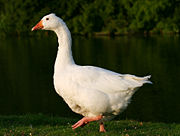
When Aphrodite first came ashore she was welcomed by the Charites (Roman "Graces"), whose chariot was drawn by geese.
There are Mother Goose tales, such as a farmwife might have told; there is the proverbial goose that laid the golden eggs, warning about the perils of greed. And there is the goose as a veiled reference to the penis in the verses
- Goosy Goosy Gander, where dost thou wander?
- Upstairs, downstairs, in my lady's chamber.
The geese in the temple of Juno on the Capitoline Hill were said by Livy to have saved Rome from the Gauls around 390 BC when they were disturbed in a night attack. The story may be an attempt to explain the origin of the sacred flock of geese at Rome.
There is a tale of Trickster and the geese in the North American Trickster cycle [1].
Liliane Bodson and Daniel Marcolungo, L'oie de bon aloi: Aspects de l'histoire ancienne de l'oie domestique [The goose in ancient life and folklore]. Vise (Musée Regional d'Archeologie et d'Histoire de Vise), 1994, discusses the image and lore of domestic geese in classical antiquity, with a separate chapter on the goose in folklore.
See also
- List of goose breeds
- Angel Wing - A disease common in geese.
References
- ↑ Buckland, R., & Guy, G. (2002). Goose Production. Chapter 1: Origins and Breeds of Domestic Geese. FAO Agriculture Department.
- ↑ 2.0 2.1 2.2 2.3 Hugo, S. (undated). Geese: the underestimated species. FAO Agriculture Department.
- ↑ 3.0 3.1 del Hoyo, J., Elliott, A., & Sargatal, J., eds. Handbook of Birds of the World Vol. 1: 581. Lynx Edicions, Barcelona. ISBN 84-87334-10-5
